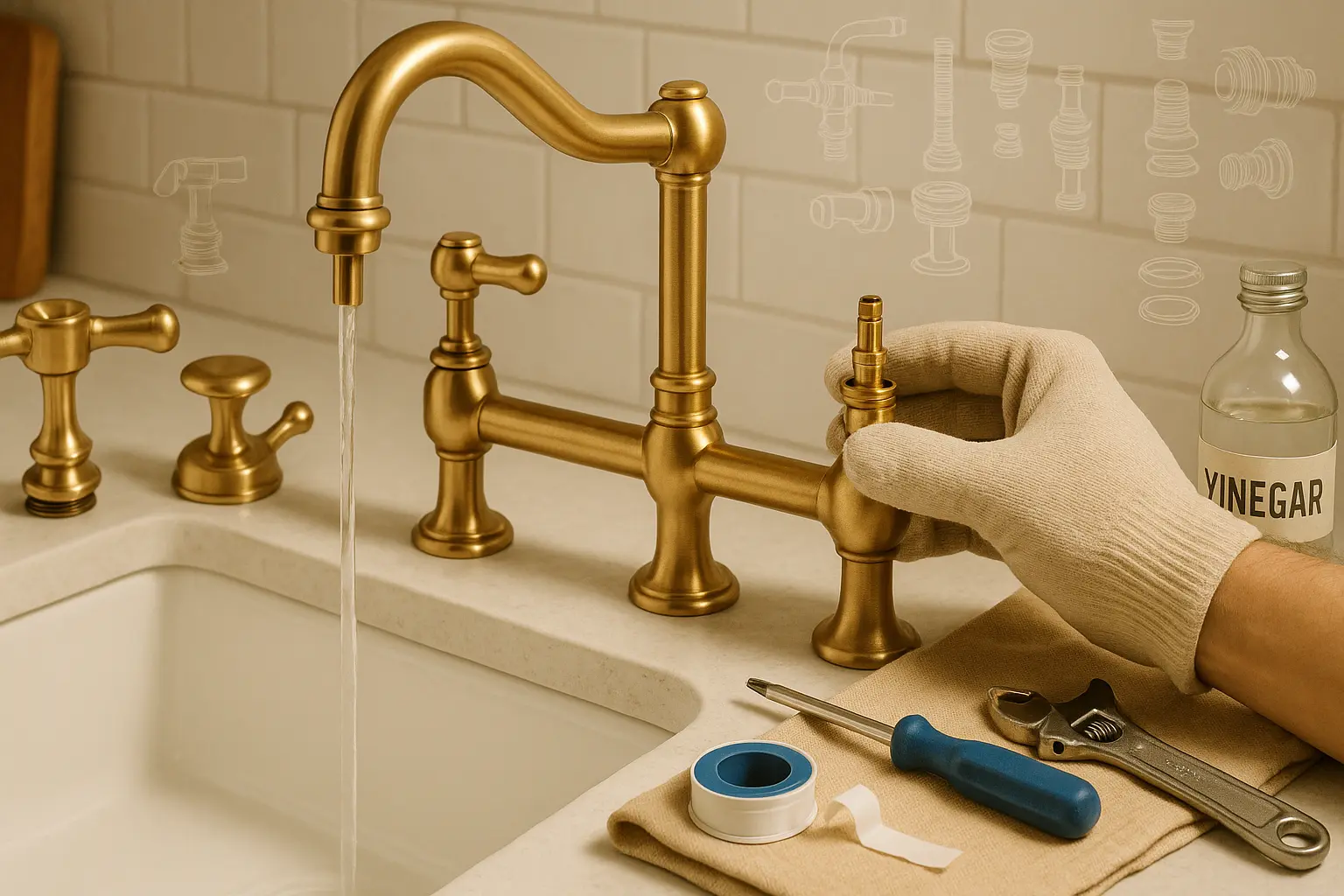
Essential Safety Features for Every Shower
Safety Features for Every Shower Shower safety is a top priority for a secure bathing environment. Falls are the leading


A persistent leak in your kitchen faucet isn’t just an annoyance—it can waste hundreds of gallons of water over time and lead to long-term damage if left unresolved. If you own a dual handle faucet, understanding the structure and identifying the source of the leak are essential first steps toward resolving the issue efficiently. Whether your faucet is a standard two-handle model or a high-end bridge faucet, most leaks can be fixed without replacing the entire fixture.
In this guide, we’ll break down the most common reasons your dual handle faucet might be leaking and walk you through quick, effective solutions to restore your faucet’s function and appearance. If you’ve invested in an unlacquered brass kitchen faucet or any other premium model, timely repair is also key to preserving the finish and preventing internal wear.
Dual handle faucets typically control hot and cold water independently, using two valves that mix water into the spout. While this setup offers precise temperature control, it also doubles the potential for leaks. Let’s look at where and why leaks happen.
Follow these steps to troubleshoot and fix a leaking faucet in your kitchen:
Locate the shutoff valves beneath your sink and close both the hot and cold water lines. Open the faucet to release pressure and any remaining water.
Use a screwdriver or Allen key to remove the set screw holding the handle in place. Carefully pull off the handle to expose the inner valve assembly.
Match the replacement washer, O-ring, or cartridge to your faucet’s make and model. Apply plumber’s grease to rubber parts before reinstalling.
Reassemble the faucet in reverse order. Turn the water supply back on and test the handles. The leak should be fully resolved—if not, double-check for overlooked wear or seating issues.
Not all dual handle faucets are built the same—and understanding what type you have can help you identify the correct repair method, choose the right replacement parts, and avoid unnecessary damage.
Compression faucets are the traditional type of two-handle faucet. They control water flow using a compression stem with a washer at the bottom. Turning the handle tightens or loosens the washer against the valve seat to control water flow.
Cartridge faucets use a valve cartridge that opens and closes to regulate water flow. These are more common in modern dual handle faucets and are easier to operate and maintain.
To determine if your dual handle faucet is a compression or cartridge type:
Knowing this not only helps you fix a leaking faucet faster—it also ensures you buy the correct replacement parts. You can find quality brass-compatible parts that match both systems in most home improvement stores, or by contacting the manufacturer of your faucet.
If you’re using a bridge faucet or other heritage fixture from Insideast, chances are you’re working with a traditional compression faucet, built for both function and long-term repairability. Check out our Best Bridge Faucets of 2025 for durable designs that are made to be maintained—not thrown away.
If your leaking faucet is a bridge-style or unlacquered brass model, it’s especially important to take care when disassembling and cleaning it. These fixtures are often handcrafted, and their finishes can be sensitive to abrasives and harsh chemicals.
Looking to install a new faucet or replace a worn bridge model? See our step-by-step bridge faucet installation guide to get started.
Once you’ve fixed the leak, take a few proactive steps to keep it from returning:
Mineral deposits can cause pressure buildup and internal leaks. Unscrew the aerator and soak it in vinegar monthly to prevent clogs.
This wears out washers and O-rings prematurely. Turn handles firmly but gently to prevent unnecessary friction and damage.
Hard water accelerates corrosion, especially in brass kitchen faucets. Installing a softener extends your faucet’s life and reduces the risk of leaks.
At least twice a year, check your faucet handles, base, and connections for early signs of wear, dripping, or movement.
Sometimes fixing a leak isn’t worth the hassle—especially if the fixture is:
If that’s the case, browse our curated unlacquered brass kitchen faucet collection or explore all our premium fixtures in the Insideast full catalog. Our faucets are crafted to combine timeless design with modern reliability.
Fixing a leaking dual handle faucet doesn’t have to be intimidating. By identifying the source of the leak whether it’s a worn washer, corroded valve seat, or faulty stem—you can solve most issues in under an hour with just a few basic tools. And when you maintain your faucet properly, you’ll avoid common failures altogether.
Looking for a long-term upgrade that blends performance and heritage craftsmanship? Explore our range of handcrafted bridge and brass faucets and keep your kitchen stylish, functional, and leak-free for years to come.

Safety Features for Every Shower Shower safety is a top priority for a secure bathing environment. Falls are the leading
Receive your order to your door address anywhere in the world using our shipping partners
You're covered by our 30 days return policy
Big part of our reviews testifies about the quality of support provided
Secured payments using renowned payment gateways